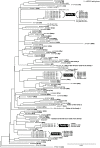Clustering infection of hepatitis B virus genotype B4 among residents in Vietnam, and its genomic characters both intra- and extra-family
- PMID: 28753615
- PMCID: PMC5533320
- DOI: 10.1371/journal.pone.0177248
Clustering infection of hepatitis B virus genotype B4 among residents in Vietnam, and its genomic characters both intra- and extra-family
Abstract
Vietnam has a high rate of hepatitis B virus (HBV) infection and a high mortality rate from hepatocellular carcinoma. We performed a detailed genetic analysis of 48 residents and four families from Binh Thuan Province, a southern coastal area of Vietnam. The route of infection and genomic characteristics related to hepatocellular carcinoma (HCC) were studied in HBV spread among carriers that we detected in our previous hepatitis survey. The HBV genotype was B4 in 91.7% and C1 in 8.3% of the cases. The intra-family's HBV sequence homology was high at 96.8-99.4%. However, it was also high at 99.4-99.8% among residents of the same age and sex as family members. In addition, full genome analysis was performed in 21 cases. The core region of all 20 isolates with genotype B4 was a recombinant of genotype C, and pre-S deletion was found in 20% of cases. The promoter mutation G1613A was found in 13.6% of cases, and a 24 bp insertion from nt1673 in the X region was found in 6.3% of cases. The phylogenetic tree and homology analysis of the HBV full genome suggested the probability and its possibility of horizontal transmission not only within families nor vertical transmission but within cohorts of the same generation in the population. Moreover, the HBV genotype B4 isolates were found not only to be recombinants of genotype C, which results in a high cancer risk, but also to have other risk of HCC, pre-S deletions, the G1613A mutation, and X region insertions corresponding to the promoter. These genomic characters were suggested to be one of the factors to explain the high HCC mortality rate in Vietnam.
Conflict of interest statement
Figures






References
-
- WHO. Hepatitits B Media Center of WHO2016 [cited 2016 october].
-
- Ghendon Y. Perinatal transmission of hepatitis B virus in high-incidence countries. J Virol Methods. 1987;17(1–2):69–79. . - PubMed
-
- Franks AL, Berg CJ, Kane MA, Browne BB, Sikes RK, Elsea WR, et al. Hepatitis B virus infection among children born in the United States to Southeast Asian refugees. N Engl J Med. 1989;321(19):1301–5. doi: 10.1056/NEJM198911093211905 . - DOI - PubMed
-
- Marinier E, Barrois V, Larouze B, London WT, Cofer A, Diakhate L, et al. Lack of perinatal transmission of hepatitis B virus infection in Senegal, West Africa. J Pediatr. 1985;106(5):843–9. . - PubMed
-
- Basalamah AH, Serebour F, Kazim E. Materno-foetal transmission of hepatitis B in Saudi Arabia. J Infect. 1984;8(3):200–4. . - PubMed
MeSH terms
Substances
LinkOut - more resources
Full Text Sources
Other Literature Sources
Medical

